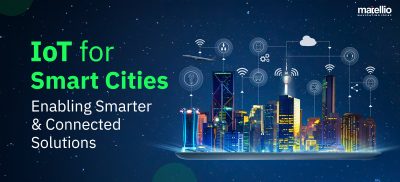
The IoT platform development marks a transformative leap in the technological landscape, reshaping how we interact with the digital world and our physical environment. In this era of digital transformation services, IoT platforms are the crucial backbone that supports a vast network of devices, from the most straightforward sensors to the most complex machines. They facilitate seamless communication between devices and enable the integration of data, analytics, and automation into our daily lives.
As we delve into IoT device management platform development, it’s essential to understand the intricate layers and innovative technologies that make up these platforms. They are not just about connecting devices; they represent a holistic ecosystem that combines hardware, software, and services, working in unison to turn raw data into actionable insights. In this blog, we’ll discuss the complexities of industrial IoT platform development. It provides insights into its fundamental components, the challenges faced during development, and the boundless possibilities it unlocks in various sectors such as healthcare, manufacturing, and smart cities.
Let’s embark on this exciting exploration of how IoT platform platforms are being developed to power the next wave of digital transformation.
Introduction of IoT Platforms
IoT platforms are crucial for the efficient and effective implementation of IoT enterprise solutions across various sectors, including smart homes, industrial automation, healthcare, smart cities, and agriculture. They enable better decision-making, efficiency, cost reduction, and new business models.
IoT device management platforms are the middle layer between the hardware (IoT devices) and application layers. They facilitate communication, data flow, device management, and the functionality of applications that use IoT devices. Essentially, they act as a bridge that connects the physical and digital worlds, enabling for the efficient management and operation of a network of industrial IoT platforms.
Types of IoT Device Management Platforms:
IoT platforms come in various types, each tailored to different aspects of the IoT. Understanding these types helps in choosing the right platform for specific needs. Here are the main types:
Connectivity/M2M Platforms
M2M (Machine-to-Machine) IoT platforms are specialized frameworks that enable direct communication and data exchange between devices or machines, leveraging IoT services. These platforms facilitate automated data transmission and operations without human intervention, making them crucial in industrial and consumer IoT applications.
IaaS (Infrastructure as a Service) Backends
Infrastructure as a Service (IaaS) in the context of IoT (Internet of Things) platforms refers to a model where the underlying infrastructure needed for industrial IoT services is provided over the Internet. In this setup, the IaaS provider offers essential computing, storage, and networking resources and on a pay-as-you-go basis. Hire IoT developers to scale and manage your IoT solutions without the complexity of managing physical servers and data center infrastructure.
Hardware-specific Platforms
Hardware-specific IoT device management platform development refers to integrated solutions that work seamlessly with specific hardware in the Internet of Things ecosystem. Unlike generic IoT device management platforms that offer broader compatibility, these are often optimized for particular types of devices or sensors, ensuring better performance, compatibility, and, often, ease of use.
Consumer/Enterprise IoT Platforms
Enterprise IoT platforms are advanced software frameworks designed to support and manage the complex requirements of IoT applications within large-scale business environments. These platforms play a crucial role in deploying, operating, and scaling IoT enterprise solutions in the enterprise sector.
Also Read- IoT Software Development: A Complete Guide
Data Analytics Platforms
Data analytics in IoT (Internet of Things) platforms is a critical aspect that involves collecting, processing, analyzing, and interpreting data generated by industrial IoT services. This process turns raw data into actionable insights, driving decisions and automating actions.
End-to-End IoT Platforms
End-to-end (E2E) IoT platforms are comprehensive software frameworks designed to facilitate the custom enterprise software development, deployment, and management of IoT device management platform. These platforms provide a full spectrum of tools and services needed to connect, manage, and indeed analyze data from IoT devices.
IoT Cloud Platforms
IoT Cloud Platforms are specialized platforms designed to support the Internet of Things (IoT) ecosystem. They provide the necessary infrastructure and services to connect, manage, and automate IoT devices and data.
IoT Application Enablement Platforms (AEP)
An IoT Application Enablement Platform (AEP) is a comprehensive set of integrated software tools and services that allow developers to build, test, deploy, and manage IoT applications and solutions. AEPs bridge the gap between the raw data collected by IoT devices and the applications that use this data to create value.
Each type of IoT platform serves different needs and aspects of IoT consulting services. The choice depends on specific project requirements, such as the scale of deployment, the types of devices used, and the desired outcomes from the IoT implementation.
Key Features to Consider During IoT Platform Development
Internet of Things (IoT) platforms are complex frameworks that provide a set of features to support and streamline the custom enterprise software development, deployment, and management of IoT devices and applications. Here are some key features of IoT platforms:
 Device Management
Device Management
This includes the ability to register, organize, monitor, and remotely manage IoT devices. It often involves functions like firmware updates, troubleshooting, and device decommissioning.
 Data Collection and Processing
Data Collection and Processing
IoT device management platforms can collect extensive amounts of data from connected devices. They offer data processing, aggregation, filtering, and analysis tools.
 Connectivity and Network Management
Connectivity and Network Management
Ensuring secure and reliable communication between devices and the platform is crucial. This feature covers protocols (like MQTT, CoAP, HTTP) and network management tools.
 Application Development and Enablement
Application Development and Enablement
Industrial IoT platforms often provide development tools and environments that help create, test, and deploy IoT applications. This can include SDKs, APIs, and pre-built templates.
 Integration Capabilities
Integration Capabilities
Integrating with other systems and applications, like ERP systems, customer relationship management (CRM) software, and other business tools, it is essential for maximizing the value of IoT consulting services.
 Security
Security
Given the sensitive nature of IoT data and the potential risks, platforms typically offer robust security features, including encryption, secure boot, access control, and regular security patches.
 Analytics and Intelligence
Analytics and Intelligence
Advanced data analytics capabilities, sometimes powered by AI and ML, allow for extracting valuable insights from data, predictive maintenance, anomaly detection, and more.
 User Interface and Experience
User Interface and Experience
A user-friendly interface for managing IoT devices and data, including dashboards, reporting tools, and visualization features, is a critical component of IoT platform development.
 Scalability and Flexibility
Scalability and Flexibility
IoT platforms must be able to scale seamlessly as the number of connected devices grows and needs to evolve. This includes supporting various device types and handling large data volumes.
 Edge Computing Support
Edge Computing Support
Some industrial IoT platform developments offer edge computing capabilities, which allow data processing to be done closer to where it is generated, reducing latency and bandwidth use.
 Compliance and Standards
Compliance and Standards
Compliance with industry standards and regulations, ensuring data privacy, and meeting legal requirements are also key features of IoT platforms.
 Multi-Tenancy and Access Control
Multi-Tenancy and Access Control
The ability to support multiple users and organizations with appropriate access control and data segmentation is important for collaborative and multi-party IoT environments.
IoT platforms are designed to be comprehensive toolsets that address the multifaceted needs of IoT ecosystems, ranging from device management and data processing to security and user experience.
Also Read- IoT Consulting Services: Everything You Need to Know
How to Build an IoT Platform?
Developing an IoT (Internet of Things) platform is a complex task involving hardware and software components and requires understanding various technologies and standards. Here’s a step-by-step guide to help you in IoT device management platform development:
Define Your Objectives and Requirements
The objective and scope of industrial IoT platform development encompass building a comprehensive, secure, and scalable framework that can support various IoT devices and applications, catering to various industry needs while ensuring user-friendliness and cost-effectiveness.
Determine what you want from your IoT platform to achieve (e.g., home automation, industrial monitoring). Understand who will use your platform (consumers, businesses, etc.). Decide on the key features and functionalities.
Tech stack for IoT Device Management Platform Development
| Hardware and Sensors | Devices and sensors for data collection (e.g., temperature sensors, motion detectors) |
| Microcontrollers and processors (e.g., Arduino, Raspberry Pi) | |
| Connectivity modules (e.g., Wi-Fi, Bluetooth, LoRa, Zigbee) | |
| Connectivity Protocols | MQTT (Message Queuing Telemetry Transport) |
| CoAP (Constrained Application Protocol) | |
| HTTP/HTTPS | |
| Advanced Message Queuing Protocol (AMQP) | |
| Networking | Network protocols (TCP/IP, UDP) |
| Cellular networks (LTE, 5G) | |
| Network security protocols (SSL/TLS) | |
| Cloud Platform (for data storage and processing) | AWS IoT Core, Azure IoT Hub, Google Cloud IoT |
| IoT-specific databases (e.g., InfluxDB, TimescaleDB) | |
| Big Data platforms (e.g., Apache Hadoop, Apache Spark) | |
| Data Processing and Analytics | Stream processing (e.g., Apache Kafka, Apache Storm) |
| Real-time analytics (e.g., Apache Flink, Elasticsearch) | |
| Machine Learning libraries (e.g., TensorFlow, Scikit-learn) | |
| Application Development | Backend development (e.g., Node.js, Python, Java) |
| Frontend development (e.g., React, Angular) | |
| RESTful API development | |
| Device Management and Security | Device authentication and authorization (OAuth 2.0, JWT) |
| Data encryption and security protocols | |
| Device lifecycle management tools | |
| User Interface and Reporting | Dashboard development tools (e.g., Grafana, Kibana) |
| Reporting and data visualization libraries (e.g., D3.js) | |
| DevOps and Containerization | Docker for containerization |
| CI\CD tools (e.g., Jenkins, GitLab CI) | |
| Kubernetes for orchestration |
Choose the Right Hardware and Software
Choosing the proper hardware and software for Industrial IoT platform development is crucial for the success of your project. Determine Your Requirements What is the primary function of your IoT device? (e.g., sensing, data processing, communication) Choose sensors (temperature, pressure, motion, etc.) and actuators (motors, LED lights) based on your application needs. Decide where data processing and analysis will occur.
Design System Architecture
Designing a system architecture in a custom enterprise software development involves creating a blueprint outlining how various IoT ecosystem components interact and function together. This architecture must be scalable, secure, and efficient designed for scalability from the beginning. Ensure the system is modular to facilitate upgrades and maintenance. Ensure your platform can indeed integrate with other systems and IoT devices.
Develop the Core Components
Developing the core components in IoT device platform development involves focusing on each critical aspect of the platform’s backbone. Create enterprise solutions for registering, tracking, and managing devices. Implement efficient data collection and processing mechanisms. Develop a user-friendly interface for interaction with the IoT system.
Implement Data Analytics and Applications
Implementing data analytics and applications in industrial IoT platform development involves several key steps, focusing on effectively gathering, analyzing, and utilizing data from IoT devices to drive insights and actions. Integrate data analytics for actionable insights. Develop applications that leverage the data collected and processed by your platform.
Focus on Security and Privacy
Focusing on Security and Privacy in industrial IoT services is critical, given the increasing prevalence of IoT devices and the sensitive nature of the data they handle. Use strong encryption for data at rest and in transit. Ensure robust user authentication and authorization. Be indeed aware of and comply with relevant data protection regulations.
Test Your Platform
Testing an IoT platform before development is crucial to ensure reliability, scalability, and security. Ensure all features work as intended. Test the platform’s ability to handle high volumes of data and numerous devices. Perform thorough security testing to identify and fix vulnerabilities.
Plan for Deployment and Maintenance
Deploying and maintaining an IoT (Internet of Things) platform is a complex process that indeed requires careful planning and ongoing management. Develop a plan for deploying your platform. Plan for regular maintenance and updates.
Launch and Iterate
Launching and iterating in industrial IoT platform development involves a dynamic and continuous process of improvement and adaptation. Consider a phased or limited release to gather initial feedback. Continuously improve the platform indeed based on user feedback and technological advancements.
Developing an IoT platform is an iterative process that involves adaptation to new technologies and market needs. It’s essential to have a solid foundational knowledge of IoT concepts and a flexible approach to design and development.
Also Read- IoT Product Development: Use Cases and Development Process
Conclusion
Custom IoT platforms are not just a technological advancement, it’s a pivotal shift in how we interact with the world around us. These platforms are the backbone of a connected environment, enabling seamless integration of devices, efficient data processing, and more intelligent decision-making. As businesses and consumers increasingly adopt IoT solutions, robust, secure, and scalable IoT platforms become paramount. So, are you ready to unleash the power of your data? Get started on your IoT platform development journey today, and let an experienced IoT development company like Matellio be your guide. Together, we can build the bridge to a smarter, more connected future.
FAQs
How can I choose the right IoT platform for my project?
Consider factors such as your project requirements, scalability needs, compatibility with devices, security features, integration capabilities, and the platform's support for future technologies.
What trends are emerging in IoT platform development?
Trends include increased use of artificial intelligence (AI) and machine learning, edge computing adoption, enhanced security measures, and the integration of 5G technology for faster and more reliable communication.
Can I integrate an IoT platform with existing enterprise systems?
Yes, custom IoT platforms are designed to integrate with existing enterprise systems, such as ERP, CRM, and data analytics tools. This ensures that IoT data can be used with other business processes.
How does an IoT platform ensure security?
Security measures include device authentication, data encryption, secure communication protocols, access control, and continuous monitoring. Many platforms also comply with industry standards and regulations.
What are the key components of an IoT platform?
Common components include device management, connectivity management, data storage and analytics, security features, application enablement, and integration with other IT systems.


 Device Management
Device Management Data Collection and Processing
Data Collection and Processing Connectivity and Network Management
Connectivity and Network Management Application Development and Enablement
Application Development and Enablement Integration Capabilities
Integration Capabilities Security
Security Analytics and Intelligence
Analytics and Intelligence User Interface and Experience
User Interface and Experience Scalability and Flexibility
Scalability and Flexibility Edge Computing Support
Edge Computing Support Compliance and Standards
Compliance and Standards Multi-Tenancy and Access Control
Multi-Tenancy and Access Control



